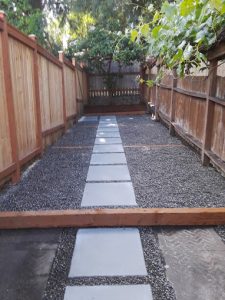Just like combing out tangles, dethatching your lawn removes the thick layer of dead grass and debris, making your lawn healthier and more vibrant. For Seattle homeowners, dethatching is an essential part of lawn maintenance, especially as the region’s mild climate encourages the growth of lush grass in the spring and summer. Over time, a layer of thatch—composed of dead grass, roots, and organic matter—can build up. While a thin layer of thatch can be beneficial, if it grows too thick, it can prevent air, water, and nutrients from reaching the soil and roots, suffocating your grass and hindering its growth.
Dethatching your lawn helps restore its health by breaking up this compacted layer, allowing your grass to thrive. Follow these steps to ensure you’re giving your lawn the care it needs to look its best.
Steps to Dethatch a Lawn:
1. Determine if Your Lawn Needs Dethatching:
The first step is to assess the thickness of the thatch layer. To do this, dig a small patch of turf about 2-3 inches deep. If the thatch is over ½ inch thick, it’s time to dethatch. If the thatch layer is thinner, it may not be necessary to dethatch, but regular lawn care and aeration can still help keep your lawn healthy.
2. Choose the Right Time:
The timing of dethatching depends on the type of grass in your lawn.
- Cool-season grasses (e.g., Kentucky bluegrass, fescue) should be dethatched in early spring or early fall when the grass is actively growing and can recover quickly.
- Warm-season grasses (e.g., Bermuda, zoysia) should be dethatched in late spring or early summer, as they grow best during the warmer months.
3. Select Dethatching Equipment:
Choose the right tools based on the size of your lawn and the thickness of the thatch.
- Manual Dethatching Rake: Ideal for small lawns or mild thatch buildup. This rake features sharp tines that pull up the thatch and allow you to remove it by hand.
- Power Dethatcher (Scarifier): For larger lawns or thicker thatch, renting or purchasing a power dethatcher is a good option. These machines dig into the soil, helping to break up even the toughest thatch layers.
4. Mow the Lawn:
Before dethatching, mow your lawn to about half its usual height. This makes the dethatching process more effective by allowing the dethatcher to make better contact with the thatch and soil. Avoid mowing too short, as this can stress the grass.
5. Dethatch the Lawn:
Once you’ve selected your dethatching equipment and mowed the lawn, it’s time to get to work. Move your dethatcher across the lawn in one direction. For deeper dethatching, make a second pass in a perpendicular direction to ensure you break up as much thatch as possible.
6. Rake Up the Thatch:
After dethatching, you’ll need to rake up the loosened thatch. This material can either be composted or discarded in your yard waste collection. Be sure to remove all the thatch to prevent it from re-compacting.
7. Aerate the Lawn (Optional but Recommended):
If your lawn is compacted, consider aerating after dethatching. Aeration helps improve soil oxygen levels, encourages deeper root growth, and improves water and nutrient absorption. Use a lawn aerator to create holes in the soil, allowing air, water, and fertilizer to penetrate more deeply.
8. Fertilize and Water:
After dethatching (and aerating if necessary), apply a balanced fertilizer to help your lawn recover. Fertilization provides essential nutrients for new growth. Follow up with a deep watering to ensure that your lawn absorbs the nutrients and remains hydrated during its recovery.
9. Overseed (if necessary):
If the dethatching process leaves bare patches or exposes thin areas of grass, overseed the lawn with a suitable grass seed. This will help fill in the gaps and promote even growth, leading to a lush, green lawn throughout the season.
Get Started
Dethatching is an important lawn maintenance task that ensures your lawn remains healthy and strong, especially in Seattle’s moist climate. By following these steps annually, you’ll create a lawn that’s better able to absorb nutrients and thrive in the growing season. With the right timing, equipment, and follow-up care, dethatching can help you achieve a beautiful, vibrant lawn that’s perfect for outdoor activities and relaxation.
Remember, dethatching removes the thick thatch layer, allowing your lawn to breathe and absorb water and nutrients more efficiently. Be sure to dethatch at the right time for your grass type, and always follow up with fertilization, watering, and overseeding for the best results.


















